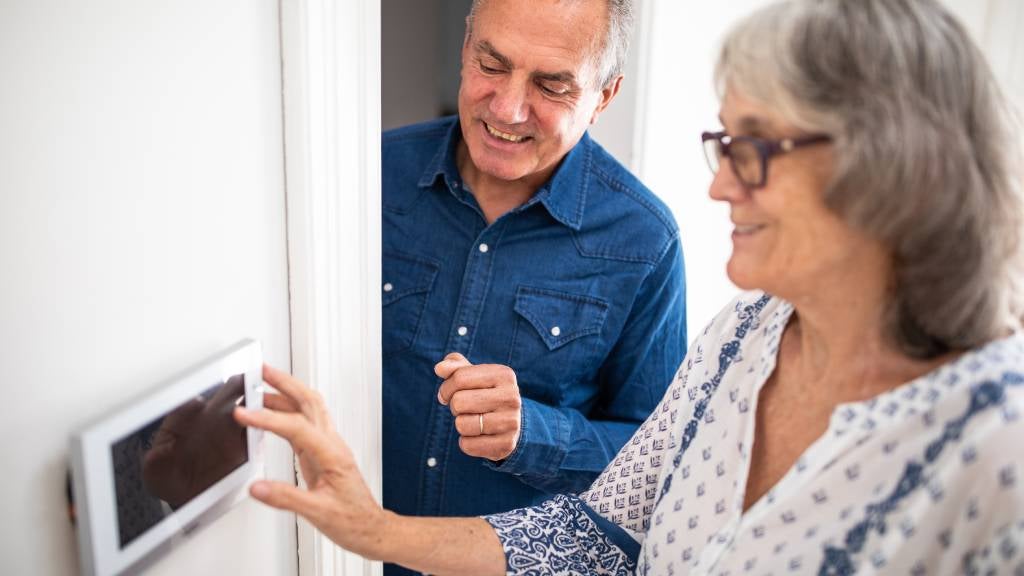Alison Kingdon’s tips on choosing a home security system

Owning a house without a security system can be risky, despite burglaries per household dropping from 12% to 10% in 2020. It’s probably fine most of the time – but there are occasions when it really could make all the difference.
As there is a lot to consider when choosing a security system for your home, we wanted to get (and share) the best advice possible, so we went to the best person we could think of for the job – Alison Kingdon. Alison is the General Manager of ADT Security New Zealand, and knows a thing or two about what to look for in a security system. We asked her about the types of systems available, and what features to look for when making a decision. You’ll find her invaluable advice throughout this blog.
What are home security systems?
A home security system is any component, or group of components, that protect your home. That could be an alarm, security cameras, motion-sensor lights, glass break sensor, or even just the stickers you put on your windows to warn unsavoury types.
Because even though New Zealand is a wonderful and relatively safe place to live, burglaries do happen. In 2022, the percentage of households or adults affected by burglary was 9%.
“Choosing the right home security system is an important decision for homeowners, especially those over 50 who value safety, simplicity, and reliability. With various options on the market, it’s important to understand what each system offers to ensure your home is well-protected and you feel secure,” explains Alison.
Expert tips on choosing a security system
Know the two main types of security systems
The first piece of knowledge you’ll need in your quest for a home security system is an understanding of the two main types.
One is DIY systems, which are quick and easy to install.
“These systems suit people who are comfortable taking a hands-on approach to their home security,” says Alison. This is a great option for tech-savvy users.
The second type is any professionally installed security system with 24/7 back-to-base monitoring.
“These systems provide added peace of mind with immediate support from a team of trained professionals,” advises Alison. Back-to-base monitoring is when your system is connected to a professional monitor. So if the alarm goes off, an expert will monitor the system to see if anything is wrong – and act on it.
“Whether it’s the hands-on appeal of DIY systems, or the comprehensive coverage offered by professionally installed and monitored systems, your choice should align with your daily needs and provide peace of mind. Remember, the right system for you is one that’s simple to manage, dependable in every situation, can be customised to your specific requirements, and equipped with features that enhance your safety,” suggests Alison.
What features to look for in any security system
With all of that in mind, Alison suggests looking for these four features, whether you’re opting for a DIY project or getting the pros in.
- A system that is easy to use is especially important.
- Access to a strong and reliable customer support service that can provide assistance whenever it is needed.
- Flexibility to be customised to specific home needs and adapted over time for enhanced security.
- Integration with additional safety features– such as personal alarms or fall detectors– for extra protection in emergencies.
What to consider when choosing a system
As Alison previously mentioned, one of the main things to look for in a security system is ease of use. It’ll be no good to you if the technology is so complicated to use, that you end up not even switching it on.
Of course, any system should offer exceptional safety. For example, a system with a camera that monitors your entryways is a great start. But if you can’t monitor those cameras yourself, professional monitoring could be one way to add extra security – especially if you travel or are away a lot.
Reliability is another item that should be on your security system shopping list. Will an alarm go off like an overactive smoke sensor every time you come home? Or will it reliably only send out the alert in an actual break-in situation?
Finally, cost can be a key factor in your choice of systems. A DIY installation is of course on the cheaper end of the scale, whereas a professional install with expert monitoring is going to come with a higher price tag. Plus, there’s more than just the initial purchase and installation costs to think about. Ongoing costs can include monitoring, upgrades, and video storage. But keep in mind, spending here could save you a lot of cash – not to mention emotional strain – in the long run.
Get home and contents insurance for extra protection
Even with precautions, it’s hard to guarantee full protection of your property. In this case, having home and contents insurance can at least offer some peace of mind. If a burglar takes off with your valuables, insurance may be able to cover the cost of replacing your household goods.
Home and contents insurance providers may offer discounts if you have a home security system. A dog might not cut it, but the better cameras, alarms, and other security features you have, the more you could save.
More insurance, more protection
While you’re thinking about insurance, consider Seniors Term Life Insurance. It isn’t designed to protect your house exactly, but rather the life you’ve worked so hard to build. Should something happen to you, it means your loved ones can get a payout to help with expenses through a truly difficult time.
Request a quote (there are just eight questions) to see how little peace of mind could cost you.
2 Apr 2024
